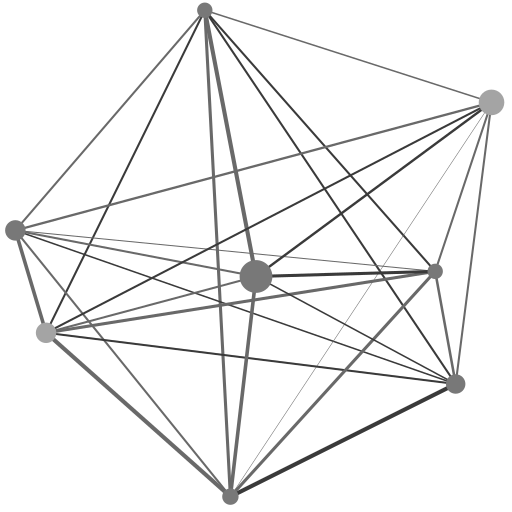Settings
Settings
Example settings file (in yaml notation):
There are 2 main keys: the devices and mappings key.
-
devices: each controlled device is listed with its configuration parameters. -
mappings: the controls between the devices are mapped together.
Devices
The type of the device must match the plugin name.
The name of the device can be anything, but must be unique.
Further options are dependent on the plugin, please read the plugin’s documentation for more information.
Mappings
The name of the mapping can be anything, but must be unique.
The from: name and to: name must match the name given to the device in the
devices setup.
The address specifies the i/o port number (modbusTCP), alias (nion) or name (websocket)
of the specific io. See the plugin specific documentation for details.
The type specifies the type that the plugin sends or expects, is required and can by any of:
-
bool →
bool -
int8 →
uint8_r -
int16 →
uint16_t -
float →
double -
string →
string
Types can be converted to one another in most cases, check the relevant plugin documentation for details.
Multiple similar mappings can be generated using the loop map.
The loop map has to contain a start and end key with integer value.
For every whole integer between the start and end (including both start and end values)
a mapping will be created with the name, from and to key & value pairs as specified.
In the mapping name and addresses a formula can be included. It must be wrapped in $(). The variable i in this
formula will be replaced with the index value of the loop. The simplest example of this would be the formula $(i)
which will return only the index of the loop. Being a formula, you can also make it something like $(i + 2)
which would result in a value of 3 when the index is 1.
A looped mapping can be specified directly on the loop element as a single mapping,
or as a list of mappings with an extra ‘mappings’ key (see the settings.yml example below).
Configuration Example
verbosity: info # <1>
# These are the default settings for the# Prometheus metrics server and endpointmetrics_bind_address: 127.0.0.1:8080metrics_endpoint_url: /metricsmetrics_enabled: true
devices: - type: modbusTCP name: Arbitrary_Unique_Name_1 verbosity: debug # <2> options: ip: 10.0.0.1 port: 502 scan_rate: 50 - type: modbusTCP name: Arbitrary_Unique_Name_2 metrics: false options: ip: 10.0.0.2 port: 502 scan_rate: 50 - type: nion name: node1 options: ip: 10.0.0.3 port: 1633 username: defaultuser password: '' - type: websocket name: websocketserver options: ip: 10.0.0.1 port: 5005 server_name: myserver
mappings: - name: test from: name: Arbitrary_Unique_Name_1 type: bool address: 1 to: name: Arbitrary_Unique_Name_2 type: bool address: 1 - name: test2 from: { name: Arbitrary_Unique_Name_1, type: bool, address: 2 } to: { name: Arbitrary_Unique_Name_2, type: bool, address: 2 } mutation: not(i) # <3> when: i # <6> # A single mapping using a loop from 0 to 7 - loop: start: 0 end: 7 name: mapping-$(i) from: name: Arbitrary_Unique_Name_1 type: bool address: $(i) } to: name: Arbitrary_Unique_Name_2 type: bool address: input_$(i+2) } # Multiple mappings using the same loop, from 0 to 7 - loop: start: 0 end: 7 mappings: - name: mapping-input-$(i) from: name: Arbitrary_Unique_Name_1, type: int16 address: $(i) to: name: Arbitrary_Unique_Name_2 type: int8 address: input_$(i+2) mutation: scale(i, int16, int8) # <4> when: i > 3 # <7> - name: mapping-output-$(i) from: name: Arbitrary_Unique_Name_2 type: int8 address: output_$(i+2) to: name: Arbitrary_Unique_Name_1 type: int16 address: $(i } mutation: scale(i, int8, int16) # <5>- verbosity level - can be any of silent, critical, warning, info, debug
- the verbosity level can be overwritten on a per plugin instance basis; the same rules apply
- this mutation inverts the value send to the
toplugin - this mutation scales the 16bit value on the
fromplugin to a 8bit value for thetoplugin - this mutation scales the 8bit value on the
fromplugin to a 16bit value for thetoplugin - with the
when: i, only rising edges will be sent out, only when the received value istrueit will be passed along to the receiver. - the
whenis processed before the mutation, in this example you can imagine filtering out some background noise from an analog input, before scaling it with the mutation.
More information on mutations, and a reference of all supported constants, operators and function can be found on the mutations page
There are also some license related arguments which you can find in the licensing section.
